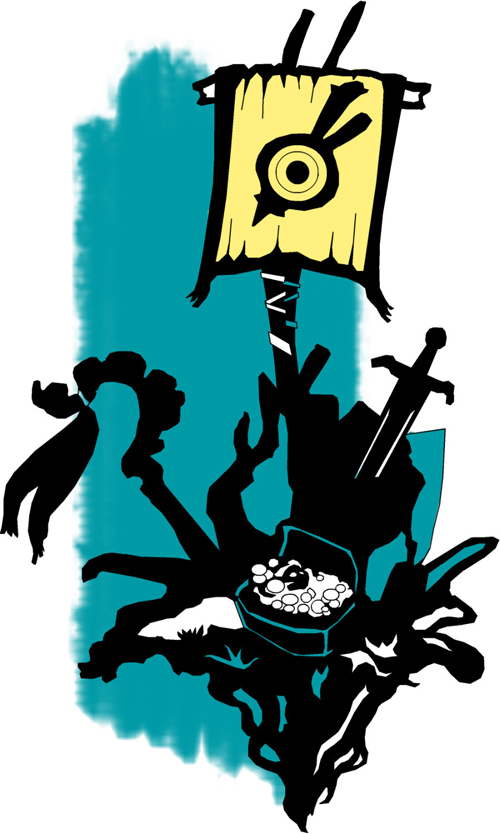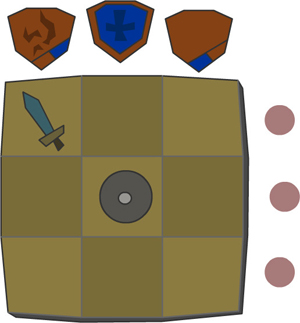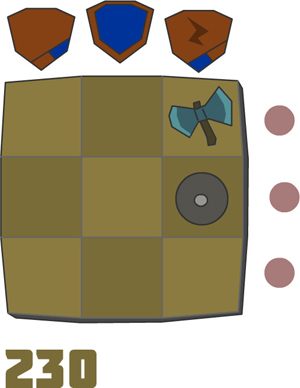Interests for the ARPG genre
Here you will find a selection of several diverse principles / mechanics for use in games like Diablo.

Listed below are the basic options for a mechanic who don’t fundamentally repeat word for word in the game - they are just some guidelines from which you can push off and adjust to your liking.
In addition to the strip of normal health, the character has a mental health scale. This is a rare resource that cannot be restored in the usual way. If it is over, then the character is available only some kind of simple weak attacking action.

The hero currently has 520 health and 800 mental health
Mental health is replenished with very rare consumables, and is also completely updated every new day (every few hours, etc).
When they hit the hero, part of the damage goes to health, and part is blocked by equipment. Part of this blocked damage damages the character’s mental health.
For example, an arrow of a skeleton archer on a hero without equipment does 40-70 damage. A hero with a total armor of his equipment equal to 25 will receive 15-45 health damage from such an arrow and, say, a tenth of the blocked damage (i.e. 2.5) will take on mental health.
Armor may have an additional absorption rate, or individual items may give absorption units instead of the armor itself. Absorption reduces mental health damage by a fixed number. For example, the absorption of 0.5 in the example above would reduce the damage to the mental health of the hero to 2.
Some particularly powerful abilities spend health or mental health on activation. In addition, paying with a waste of mental health, you can nullify the cooldown of abilities, using them ahead of schedule.
An additional feature - when the hero loses his last mental health as a result of having received damage, for a few seconds he has a sharp residual surge of strength - he moves faster and his blows do much more damage.
The loot chosen by the character (perhaps not all) sticks to a special cube displayed in the corner of the screen, where it can be shifted between cells of the current side.

In the picture, the loot is shown with items of equipment, but it can be some simpler things, like crystals / claws / stones
There is an icon above each loot column - it shows the ability that is available to the character. The icon on the left shows the ability on the left mouse button (something like an auto-attack with an additional effect), the icon in the center shows a protective buff (or passive ability), the icon on the right shows the ability on the right mouse button (most often having a cooldown and / or spending resource).
Character abilities change if you change the loot inside their column and different combinations can give different new abilities (while the recipes do not depend on the order of items in the column). In addition, parts of the cube can be rotated, gaining access to another loot or throwing out a loot there, unnecessary for abilities.

Here we twist the top of the cube, removing the sword.
Unnecessary loot can be either sold or destroyed, getting a special resource that is spent on rotating parts of the cube. It makes sense to save some items inside the cube, because they give a certain bonus while they are there. Also, in a separate menu, the hero can put out equipment, and for donning exactly those things are available that are stored in the cube.

The combination of ax and shield gives the hero a new ability on the right button. It is indicated below that the hero now has 230 units of the resource used for turns. A turn spends a certain amount of these units.
You might think about the ability to fix the current created ability so that column manipulations temporarily do not touch it. But on twists, you can spend not an abstract resource, but actually earned experience itself. Which is also abstract, but not the essence.
The game system can be built around taking into account those zones on the body of the monster that the hero attacks. For example, there can be 4 such zones: head, arms, body, legs.

Zone icon displayed on screen
The player pre-clicks on one of the zones where his character will aim during the attacks. While the head is selected, the hero attacks all monsters in the head, while the legs - on the legs and so on. You can change the zone at any time.

In the left picture, the player chose to carry out attacks on the body, and on the right he switched the attention of the hero to the zone of hands.
Various parameters change depending on the selected zone. An attack in the body zone is standard, if the remaining groups are selected, then it becomes more difficult to get into. Getting into the head zone is the most difficult of all, but such attacks will penetrate through the defense and / or inflict critical damage. Attacks on the legs can slow down or even immobilize targets, and attacks on the hands can knock out an enemy’s weapon or weaken the strength of his attacks.
Certain types of monsters may have certain vulnerabilities or protection against attacks in different types of zones. For example, an enemy with a bone head or helmet may have an even more complicated hit in the head, and enemies with many limbs may be immune to slowing when successfully shooting at their legs. Animation of monster deaths may also vary depending on the activated zone.
The hero’s outfit, in turn, can also be created to cover various of his zones, then monsters of different types can themselves have their preferred zones where they will attack the hero at a meeting.
I love multi-level dungeons as the main background for the whole game - they have some special atmosphere, different from games, where fields, fields, forests, cities and only occasionally go down to shallow caves.
It would be possible to transform this concept of a multi-level dungeon into ... the passage of a multi-level flying pyramid. Ancient fantasy, or flying from outer space, or both together - here you can widely deploy, combining fantasy and technology. And in this way of posing the question, it becomes even more clear where the final boss is.
One of the additional features of adventures is precisely in the pyramid - here you can realize breaks between levels, where you can fall off from an enemy’s blow (and spend some time trying to get here again) or purposefully jump down - for example, finding a secret room that you couldn’t get into on the previous floor.
Here are such rough sketches. What would you come up with for ARPG games?
PS Not quite a concept, but just thoughts about technical points. For games like Diablo, a statically fixed camera is usually characteristic, all kinds of zoom and changing the camera angle here are not really needed here. That is, the character himself, his equipment, monsters, and so on - can be completely done not in honest 3D, but in pre-rendered animations, the old fashioned way. Hard disk space has long been able to store large amounts of data, too many degrees of freedom are not required, but ideally you can get very smooth and highly detailed animations, a beautiful prerender that moves very naturally. Waving raincoats, a feeling of the character’s weight, in general, all kinds of beauty. And to start the game, you don’t need some kind of super-machine, and not even the most powerful hardware. Of course, someone does this too, although rarely, but these are usually some rather cartoonish projects with deliberately twitching dynamics, and one could make a quite realistic picture with very smooth animations.

Listed below are the basic options for a mechanic who don’t fundamentally repeat word for word in the game - they are just some guidelines from which you can push off and adjust to your liking.
Mental health
In addition to the strip of normal health, the character has a mental health scale. This is a rare resource that cannot be restored in the usual way. If it is over, then the character is available only some kind of simple weak attacking action.

The hero currently has 520 health and 800 mental health
Mental health is replenished with very rare consumables, and is also completely updated every new day (every few hours, etc).
When they hit the hero, part of the damage goes to health, and part is blocked by equipment. Part of this blocked damage damages the character’s mental health.
For example, an arrow of a skeleton archer on a hero without equipment does 40-70 damage. A hero with a total armor of his equipment equal to 25 will receive 15-45 health damage from such an arrow and, say, a tenth of the blocked damage (i.e. 2.5) will take on mental health.
Armor may have an additional absorption rate, or individual items may give absorption units instead of the armor itself. Absorption reduces mental health damage by a fixed number. For example, the absorption of 0.5 in the example above would reduce the damage to the mental health of the hero to 2.
Some particularly powerful abilities spend health or mental health on activation. In addition, paying with a waste of mental health, you can nullify the cooldown of abilities, using them ahead of schedule.
An additional feature - when the hero loses his last mental health as a result of having received damage, for a few seconds he has a sharp residual surge of strength - he moves faster and his blows do much more damage.
Gift Cube
The loot chosen by the character (perhaps not all) sticks to a special cube displayed in the corner of the screen, where it can be shifted between cells of the current side.

In the picture, the loot is shown with items of equipment, but it can be some simpler things, like crystals / claws / stones
There is an icon above each loot column - it shows the ability that is available to the character. The icon on the left shows the ability on the left mouse button (something like an auto-attack with an additional effect), the icon in the center shows a protective buff (or passive ability), the icon on the right shows the ability on the right mouse button (most often having a cooldown and / or spending resource).
Character abilities change if you change the loot inside their column and different combinations can give different new abilities (while the recipes do not depend on the order of items in the column). In addition, parts of the cube can be rotated, gaining access to another loot or throwing out a loot there, unnecessary for abilities.

Here we twist the top of the cube, removing the sword.
Unnecessary loot can be either sold or destroyed, getting a special resource that is spent on rotating parts of the cube. It makes sense to save some items inside the cube, because they give a certain bonus while they are there. Also, in a separate menu, the hero can put out equipment, and for donning exactly those things are available that are stored in the cube.

The combination of ax and shield gives the hero a new ability on the right button. It is indicated below that the hero now has 230 units of the resource used for turns. A turn spends a certain amount of these units.
You might think about the ability to fix the current created ability so that column manipulations temporarily do not touch it. But on twists, you can spend not an abstract resource, but actually earned experience itself. Which is also abstract, but not the essence.
Damage zones
The game system can be built around taking into account those zones on the body of the monster that the hero attacks. For example, there can be 4 such zones: head, arms, body, legs.

Zone icon displayed on screen
The player pre-clicks on one of the zones where his character will aim during the attacks. While the head is selected, the hero attacks all monsters in the head, while the legs - on the legs and so on. You can change the zone at any time.

In the left picture, the player chose to carry out attacks on the body, and on the right he switched the attention of the hero to the zone of hands.
Various parameters change depending on the selected zone. An attack in the body zone is standard, if the remaining groups are selected, then it becomes more difficult to get into. Getting into the head zone is the most difficult of all, but such attacks will penetrate through the defense and / or inflict critical damage. Attacks on the legs can slow down or even immobilize targets, and attacks on the hands can knock out an enemy’s weapon or weaken the strength of his attacks.
Certain types of monsters may have certain vulnerabilities or protection against attacks in different types of zones. For example, an enemy with a bone head or helmet may have an even more complicated hit in the head, and enemies with many limbs may be immune to slowing when successfully shooting at their legs. Animation of monster deaths may also vary depending on the activated zone.
The hero’s outfit, in turn, can also be created to cover various of his zones, then monsters of different types can themselves have their preferred zones where they will attack the hero at a meeting.
Extraterrestrial pyramid
I love multi-level dungeons as the main background for the whole game - they have some special atmosphere, different from games, where fields, fields, forests, cities and only occasionally go down to shallow caves.
It would be possible to transform this concept of a multi-level dungeon into ... the passage of a multi-level flying pyramid. Ancient fantasy, or flying from outer space, or both together - here you can widely deploy, combining fantasy and technology. And in this way of posing the question, it becomes even more clear where the final boss is.
One of the additional features of adventures is precisely in the pyramid - here you can realize breaks between levels, where you can fall off from an enemy’s blow (and spend some time trying to get here again) or purposefully jump down - for example, finding a secret room that you couldn’t get into on the previous floor.
Here are such rough sketches. What would you come up with for ARPG games?
PS Not quite a concept, but just thoughts about technical points. For games like Diablo, a statically fixed camera is usually characteristic, all kinds of zoom and changing the camera angle here are not really needed here. That is, the character himself, his equipment, monsters, and so on - can be completely done not in honest 3D, but in pre-rendered animations, the old fashioned way. Hard disk space has long been able to store large amounts of data, too many degrees of freedom are not required, but ideally you can get very smooth and highly detailed animations, a beautiful prerender that moves very naturally. Waving raincoats, a feeling of the character’s weight, in general, all kinds of beauty. And to start the game, you don’t need some kind of super-machine, and not even the most powerful hardware. Of course, someone does this too, although rarely, but these are usually some rather cartoonish projects with deliberately twitching dynamics, and one could make a quite realistic picture with very smooth animations.
All Articles